Published: November 22, 2022
Updated: November 9, 2023
Managing contracts on a SaaS (software-as-a-service) contract management platform offers your company the flexibility to manage your agreements without the usual complexities of on-premises applications — complexities like data center technology infrastructure overhead, disruptive software upgrades, rigid workflows, and complex integration protocols. Not to mention the need for costly, complicated business intelligence software so contract authors can access your office network or a VPN to access and use the system.
The Evolution of SaaS
Detractors of early SaaS contract management systems used to cite concerns about data security and scalability; now, leading platforms from vendors like ContractPodAi have matured and evolved. The security posture, expandability, and extensibility of select SaaS business solution providers now meet or exceed the high standards of industries like banking and finance.
The best way for your business to maximize your contract management software return on investment (ROI) is to follow the SaaS contract management process best practices established by organizations like yours that already run these applications.
Embracing the SaaS Advantage
Companies that subscribe to cloud-based contract management software avoid the costs and time of maintaining complex hardware and software. Their administrator and cross-organizational user adoption rates are generally higher because SaaS contract systems are device agnostic and accessible from wherever internet access is available.
The SaaS advantage doesn’t stop at cost savings. It also offers scalability, flexibility, and security. While detractors of early SaaS contract management systems used to cite concerns about data security and scalability, leading platforms from vendors like ContractPodAi have matured and evolved to address these issues effectively. The security posture, expandability, and extensibility of select SaaS business solution providers now meet or exceed the high standards of industries like banking and finance.
What is SaaS Contract Management?
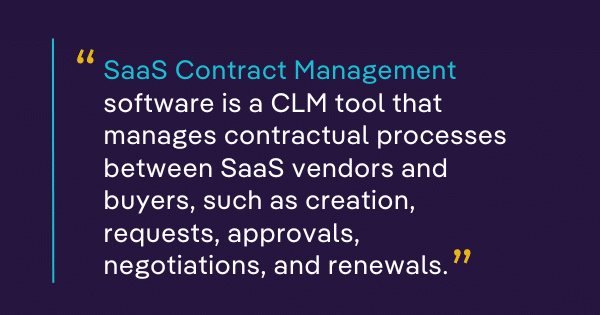
SaaS Contract Management software is a CLM tool that manages contractual processes between SaaS vendors and buyers, such as creation, requests, approvals, negotiations, and renewals.
One of the critical differences between SaaS contract management and traditional contract management is the focus on recurring revenue streams. With SaaS products, customers typically pay a monthly or annual subscription fee, rather than a one-time purchase price. Because of this, SaaS contract management must consider key milestones, like contract creation, negotiations and renegotiations, renewals, and changes to the agreement. As the use of SaaS applications continues to grow, so does the need for effective SaaS contract management.
Contract management software like ContractPodAi streamlines the creation and maintenance of legal documents. It makes the contract negotiation process and renewals easier and quicker. And it makes day-to-day contracts far more manageable within a single platform.
SaaS Contract Management Best Practices
In business technology, poor contract management (and when traveling through deep snow), it is wiser to follow in the footsteps of those who completed their journey successfully or continue to thrive. Trying to blaze your own trail and develop your contract management processes is risky and frequently doomed to fail.
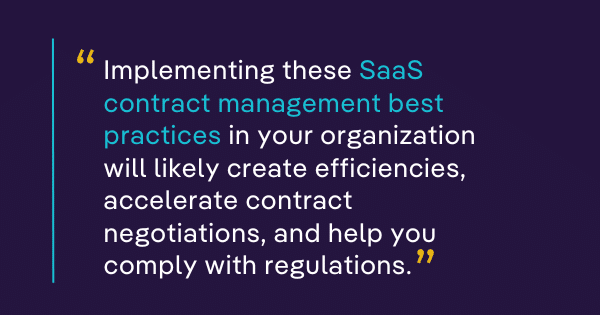
Whether a colleague shared these SaaS contract best practices with you or you discovered them yourself online, putting them to use in your organization is safer than reinventing the wheel. Implementing them in your organization will likely create efficiencies, accelerate contract negotiations, and help you comply with regulations.
Just be sure to implement a SaaS contract management platform to support these best practices to avoid getting locked into systems that prevent your business from evolving and meeting your digital transformation goals.
SaaS Contract Management Best Practices
- Create a System of Record
- Be Aware of Auto-Renewal
- Be Proactive
- Always Invoice
- Ask About Usage Limits
- Consider Multi-Year Agreements
- Future-Proof Your Contracts
1. Create a System of Record
Have you worked with colleagues in roles like systems analysts, contract administrators, or legal counsel for a long time? Or maybe these roles describe your everyday responsibilities.
Either way, the predictability and reliability of a contract management system of record are very comforting amidst the maelstrom of documents and data they work with daily.
Let’s say an audit, unexpected litigation, or missed contract obligation arises. If you have a comprehensive, expertly implemented SaaS contract management application in place as a system of record, all of your colleagues listed above can rest assured that:
- If your company authored the agreement, the terms were assembled and vetted according to defined business policies that are configured into the contract software.
- The agreement can be found in the contract repository based on its metadata, along with any versions and redlines associated with them.
- The contract was approved according to pre-defined workflows.
- There is an AI-powered analytics engine that can identify contract patterns and characteristics like contract renewal dates, at-risk obligations, and non-standard terms.
- Their contracts are stored in a highly secure cloud hosting environment that meets regulatory standards.
- Only those with role or explicit access permissions to contracts would be able to view, edit, delete, or share contracts.
As revenue-centric legal documents, contract lifecycle management software must be a system of record for your organization, for these reasons and several others.
2. Be Aware of Auto-Renewal
In our business and personal lives, being on the buy side of an auto-renewing contract can leave us paying for goods or services beyond their usefulness date. Contract service providers or buyers who manage agreements may lose their ability to renegotiate contract terms such as price or deliverables, even when a business relationship is going to everyone’s satisfaction.
By being aware of upcoming contract renewal dates or auto-renewal, each party can reassess a business relationship relative to current circumstances as the end of the term approaches. They can determine whether they can continue under the same terms, renegotiate factors like price, or find another supplier or contractor to meet their needs.
Vendor lock-in was (and remains) one of the challenges companies experience with on-premises software vendors. SaaS contract management platforms like ContractPodAi mitigate this risk and offer powerful analytics to identify auto-renewing contracts–before your organization must endure a business relationship longer than expected.
3. Be Proactive
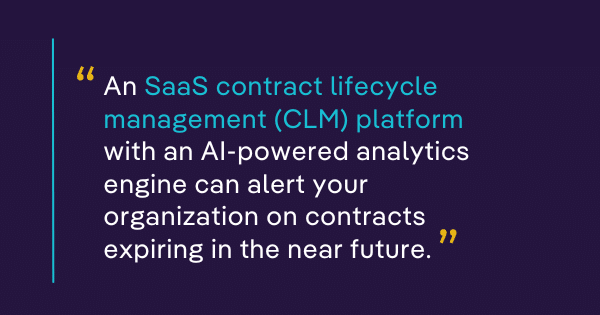
A SaaS contract lifecycle management (CLM) platform with an AI-powered analytics engine can alert your organization on contracts expiring in the near future. Sales representatives or account managers can contact your clients to address any obstacles or objections preventing contract renewal.
It can also provide other predictive analytics to enable your project managers or finance teams to reach out to customers or service providers to check on a milestone or procurement managers to follow up on delivery shortages or other supply issues.
Contract management SaaS applications provide critical information for you to act on before a relationship violates the initial or amended agreement terms.
4. Always Invoice
No matter how close and trusting your relationship with another business or contractor might be, the importance of invoices cannot be overstated. Invoices serve as the lifeblood of any professional transaction, creating an indispensable paper trail that offers protection and clarity to all parties involved.
These documents serve a multifaceted role, offering a comprehensive record of the entire transaction journey, from the initial contract creation process through the subsequent billing and, ultimately, to the receipt of payment.
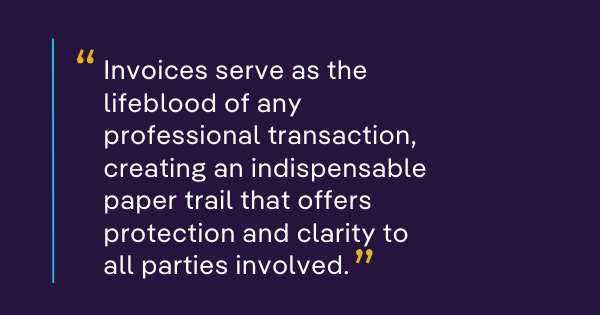
Invoices are the detailed chronicle of your business interactions, akin to a meticulously crafted story that unfolds with each transaction. Their significance stretches far beyond mere record-keeping, extending into the realms of financial management, accountability, and legal compliance.
For instance, when it comes to tax accounting, invoices become invaluable tools, ensuring that all financial transactions are accurately documented, making the process of tax preparation much more streamlined and less prone to errors or discrepancies.
But the utility of invoices doesn’t end there. They also function as a safeguard against unforeseen complications and disputes. In the world of commerce, not everything always goes according to plan. Products may fall short of expectations, services may not meet agreed-upon standards, or relationships may hit unexpected bumps along the way. In such instances, having a well-documented invoice can prove to be a lifeline, diffusing tension and minimizing confusion.
Consider a scenario where a verbal agreement was struck with a handshake and a nod. If later on, disagreements arise regarding the terms or the quality of the products or services delivered, emotions can run high, and communication can break down.
However, if there’s a clear and comprehensive invoice that outlines the agreed-upon terms, pricing, and delivery expectations, it becomes a tangible point of reference that both parties can rely upon to resolve any issues amicably and efficiently. It’s the ultimate source of truth in the midst of ambiguity.
Moreover, invoices play a pivotal role in facilitating future transactions. They provide a historical record that can be used to assess the success of past dealings, helping businesses make informed decisions about future collaborations. For example, if a supplier consistently delivers quality products and adheres to agreed-upon terms, the invoice history becomes a valuable resource for expediting future orders and building a stronger business partnership.
While a handshake deal may seem appealing in the moment, especially when trust is high, it’s the invoice that transforms a casual agreement into a professional and accountable transaction.
So, the next time you’re tempted to rely solely on trust, remember that an invoice is not just a piece of paper; it’s a powerful tool that protects, informs, and propels your business forward.
5. Ask About Usage Limits
In industries like telecommunications, technology, real estate, or automotive, leasing, usage limits, and overage fees significantly impact client costs and service provider charges. Are usage limits included in your pricing based on user numbers, data consumption, or other factors? Automate your contract review tools to include or verify them.
For buyers and sellers in these sectors, incorporating usage limits and overage fees into contracts is crucial for financial clarity and accountability. This proactive approach ensures transparent, predictable costs in an ever-evolving business landscape. By addressing these key elements, you empower your organization to navigate usage-based pricing confidently.
6. Consider Multi-Year Agreements
Multi-year agreements can be advantageous for both buyers and suppliers. The vendor can mitigate churn for those customers who opt-in, develop deeper relationships with clients, and keep their sales team focused on pursuing new business.
Buyers can access discounts by signing a long-term agreement to be protected from price increases during their term. SaaS vendors often provide incentives for customers to sign on for multiple years. Contract manufacturers, also if they need to invest in new equipment or retrofit their factories.
If your business is offered a multi-year purchase contract, be sure there are fair early termination clauses in case of poor quality or service so you aren’t locked into an untenable arrangement.
7. Future-Proofing Your Contracts for Long-Term Success
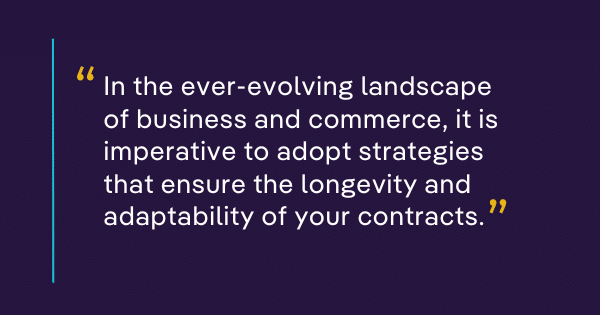
In the ever-evolving landscape of business and commerce, it is imperative to adopt strategies that ensure the longevity and adaptability of your contracts.
One such crucial strategy is the incorporation of early termination clauses. These clauses serve as invaluable tools in the arsenal of any forward-thinking company, providing an essential “escape route” should a business relationship fail to align with initial expectations set forth when the contract was originally inked.
However, the need for future-proofing extends beyond the scope of mere disagreements or misaligned objectives. We live in a world where unforeseen circumstances can disrupt the most meticulously crafted agreements.
Events such as global pandemics, unexpected labor strikes, or infrastructure failures can wreak havoc on even the most well-thought-out contracts. It is in these moments of crisis that the true resilience of a contract is tested.
To fortify your contracts against such unpredictable disruptions, it is crucial to incorporate comprehensive force majeure provisions. These provisions act as robust safeguards, providing a legal framework to address and mitigate the impact of “acts of God” or other force majeure events that render the fulfillment of contractual obligations impossible or impractical.
By integrating early termination clauses and robust force majeure provisions into your contracts, you not only safeguard your company’s interests but also demonstrate a commitment to adaptability and preparedness for the uncertainties of the future.
These proactive measures not only protect your investments but also foster trust and transparency in your business relationships, ensuring that your agreements remain resilient and adaptable in the face of an ever-changing business landscape. In this way, you are not merely signing contracts; you are future-proofing your business for sustainable success.
End-to-End SaaS Contract Management
Embracing the advantages of SaaS contract management is not just a cost-saving measure but a strategic move towards scalability, flexibility, and enhanced security. The concerns about data security and scalability that once haunted early SaaS contract management systems have largely been addressed by leading platforms like ContractPodAi. These platforms have evolved to meet or exceed the stringent standards of industries such as banking and finance. As the use of SaaS applications continues to grow, so does the need for effective SaaS contract management.
By adhering to best practices such as creating a robust system of record, staying vigilant about auto-renewals, being proactive in contract management, always invoicing, considering multi-year agreements, and future-proofing contracts, your organization can maximize the benefits of SaaS contract management and ensure a smoother, more efficient contract lifecycle management process. Implementing a cloud-based CLM system provides a comprehensive end-to-end solution that simplifies the management of contracts, aligns with your business processes, and enhances collaboration across your organization.
Visit here for more information on ContractPodAi’s SaaS platform.









